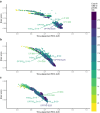Type 1 diabetes prediction in autoantibody-positive individuals: performance, time and money matter
- PMID: 40347237
- PMCID: PMC12245984
- DOI: 10.1007/s00125-025-06434-2
Type 1 diabetes prediction in autoantibody-positive individuals: performance, time and money matter
Abstract
Aims/hypothesis: Efficient prediction of clinical type 1 diabetes is important for risk stratification and monitoring of autoantibody-positive individuals. In this study, we compared type 1 diabetes predictive models for predictive performance, cost and participant time needed for testing.
Methods: We developed 1943 predictive models using a Cox model based on a type 1 diabetes genetic risk score (GRS2), autoantibody count and types, BMI, age, self-reported gender and OGTT-derived glucose and C-peptide measures. We trained and validated the models using halves of a dataset comprising autoantibody-positive first-degree relatives of individuals with type 1 diabetes (n=3967, 49% female, 14.9 ± 12.1 years of age) from the TrialNet Pathway to Prevention study. The median duration of follow-up was 4.7 years (IQR 2.0-8.1), and 1311 participants developed clinical type 1 diabetes. Models were compared for predictive performances, estimated cost and participant time.
Results: Models that included metabolic measures had best performance, with most exhibiting small performance differences (less than 3% and p>0.05). However, the cost and participant time associated with measuring metabolic variables ranged between US$56 and US$293 and 10-165 min, respectively. The predictive model performance had temporal variability, with the highest GRS2 influence and discriminative power being exhibited in the earliest preclinical stages. OGTT-derived metabolic measures had a similar performance to HbA1c- or Index60-derived models, with an important difference in cost and participant time.
Conclusions/interpretation: Cost-performance model analyses identified trade-offs between cost and performance models, and identified cost-minimising options to tailor risk-screening strategies.
Keywords: Cost analysis; Genetics; Metabolic; Performance assessment; Predictive model; Type 1 diabetes.
© 2025. The Author(s).
Conflict of interest statement
Acknowledgements: Parts of the content of this manuscript were communicated as an oral presentation at the ADA 81st Scientific Meeting in June 2021 and at the 6th Annual Diabetes Prevention Symposium in November 2023. Data availability: The datasets generated during and/or analysed in the current study are available from the corresponding author upon reasonable request. Interactive figures can be found online at https://lauricf.github.io/interactive_suplement.github.io/ . Code availability: The R code and the predictive model parameters that belong to the Pareto front are available at https://github.com/LauricF/ptm_performance.git . Code to generate the HLA interaction part of the GRS2 is freely available online ( https://github.com/t2diabetesgenes/t1dgrs2 ). Funding: Open access funding provided by University of Geneva. This work was funded by NIH grants R01 DK121843-01 (to MJR, AKS, LY, SO-G, PAG, SSR, JK and RAO) and grant 3-SRA-2019-827-S-B from Breakthrough T1D (formerly known as JDRF) (to LAF and RAO). TMT is supported by National Institute of Diabetes and Digestive and Kidney Diseases grant K23 DK136931. The Type 1 Diabetes TrialNet Study Group is a clinical trials network that is currently funded by the NIH through the National Institute of Diabetes and Digestive and Kidney Diseases, the National Institute of Allergy and Infectious Diseases, and The Eunice Kennedy Shriver National Institute of Child Health and Human Development, through the cooperative agreements U01 DK061010, U01 DK061034, U01 DK061042, U01 DK061058, U01 DK085461, U01 DK085465, U01 DK085466, U01 DK085476, U01 DK085499, U01 DK085509, U01 DK103180, U01 DK103153, U01 DK103266, U01 DK103282, U01 DK106984, U01 DK106994, U01 DK107013, U01 DK107014, UC4 DK106993, UC4DK117009, and by Breakthrough T1D (formerly known as JDRF). The contents of this article are solely the responsibility of the authors and do not necessarily represent the official views of the NIH or Breakthrough T1D. Authors’ relationships and activities: RAO has received consulting fees from Janssen R & D, and previously held a UK MRC Confidence in Concept grant to develop a 10 SNP type 1 diabetes GRS biochip with Randox R & D, and received research funding from Randox R & D. MJR is a member of the Editorial Board of Diabetologia. The remaining authors declare that there are no relationships or activities that might bias, or be perceived to bias, their work. Contribution statement: LAF, ELT, RAO and MJR contributed to the study design, as well as data analysis and interpretation, and wrote the first draft of the manuscript. AKS, RBM, JK, HMP and LY contributed to the study design and data interpretation. PAG, SO-G, TMT and SSR contributed to data interpretation. All authors revised, edited and approved the final version of the manuscript. AKS, HMP, LY, PAG, TMT, JK and MJR were members of the Type 1 Diabetes TrialNet Study Group at the time of the study. LAF, RAO and MJR are the guarantors of this article and take full responsibility for the work as a whole, including the study design, access to data and the decision to submit and publish the manuscript.
Figures



References
-
- Winkler C, Schober E, Ziegler AG, Holl RW (2012) Markedly reduced rate of diabetic ketoacidosis at onset of type 1 diabetes in relatives screened for islet autoantibodies. Pediatr Diabetes 13(4):301–306. 10.1111/j.1399-5448.2011.00829.x - PubMed
MeSH terms
Substances
Grants and funding
LinkOut - more resources
Full Text Sources
Medical
Miscellaneous

